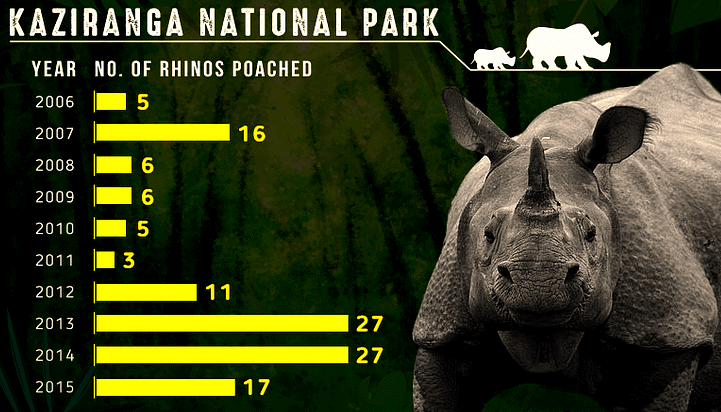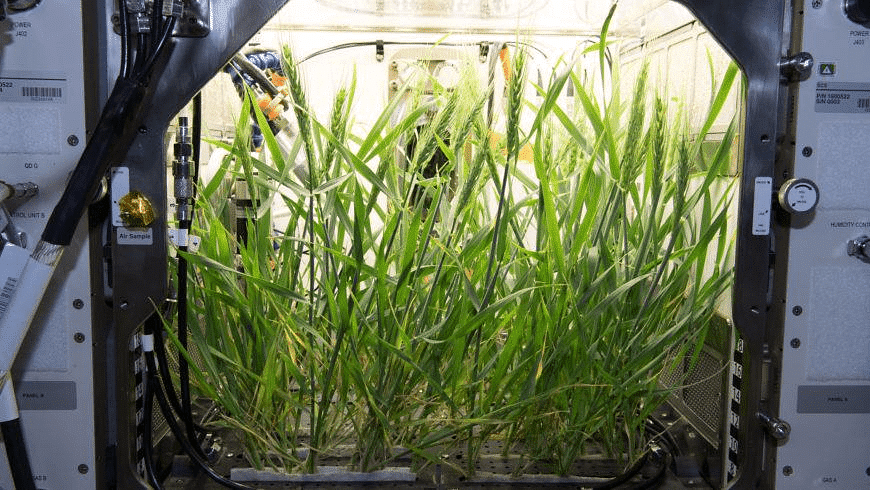October 2020: Current Affairs Environment & Ecology- 2 | Environment & Additional Topics for State PSC Exams - BPSC (Bihar) PDF Download
Parasitic Infections in One-Horned Rhinoceros
Recently, Assam and West Bengal have published reports titled 'Prevalence of Endoparasitic Infections in Free-Ranging Greater One-Horned Rhinoceros' by the World Wildlife Fund (WWF) India.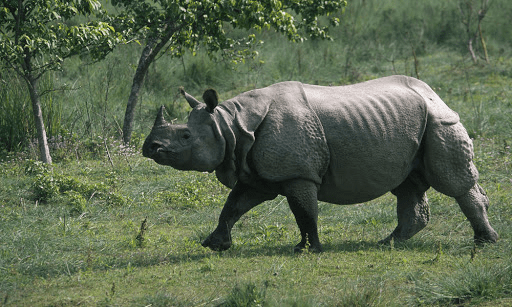 Greater One-Horned Rhino
Greater One-Horned Rhino
Core Points
- Poaching is believed to be the main cause of death for rhinos, but they also die from natural causes that have not been studied in great detail.
- The Rhino Task Force of Assam and WWF India have been undertaking steps since 2017 to study pathogens found in Assam, Uttar Pradesh and West Bengal in fresh rhino dung samples.
- No systematic study was conducted before this on the prevalence of disease-causing parasites and diseases caused by them in India's rhino population.
- Habitat degradation can lead to increased exposure to pathogens, according to the researchers.
- There is a potential threat of pathogens being transferred from domestic animals to wild animals because of increasing livestock pressure on protected areas.
- The study concluded from the Assam and West Bengal samples that parasites from four genera were present in an estimated 68% of India's rhino population.
- The overall prevalence of endoparasites in Assam was 58.57 per cent and in West Bengal, 88.46 per cent; UP results are pending.
Endoparasites live in their hosts' tissues and organs, such as tapeworms, flukes, and vertebrate protozoans.
In Asia, there are three rhino species
Greater one-horned, Javan and Sumatran (Rhinoceros unicorns).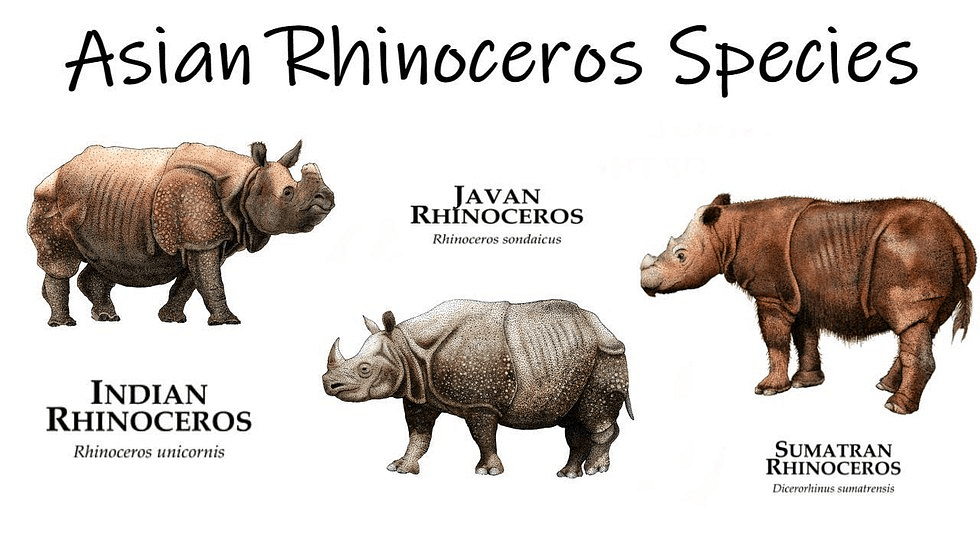
- The two greatest threats to the survival of Asian rhinos are poaching for horns and habitat loss.
 Number of Rhino's Poached in Kaziranga National Park
Number of Rhino's Poached in Kaziranga National Park - The five countries of the rhino range (India, Bhutan, Nepal, Indonesia and Malaysia) have signed a declaration on the conservation and protection of the species' New Delhi Declaration on Asian Rhinos 2019.'
➤ Status of Protection:
- Javan and Sumatran Rhino are critically endangered, and the IUCN.
- Red List is vulnerable to the Greater one-horned (or Indian) rhino.
- All three of those listed in Appendix I (CITES).
- The Greater one-horned rhino is listed under the 1972 Wildlife Protection Act, Schedule I.
➤ The Greater One-Horned Rhino Habitat:
- The species is restricted to Indo-Nepal terai and northwestern Bengal and Assam to small habitats.
- Rhinos are found primarily in Kaziranga NP, Pobitora WLS, Orang NP, Manas NP in Assam, Jaldapara NP, Gorumara NP in West Bengal Dudhwa TR in Uttar Pradesh in India.
➤ Efforts for conservation by India:
- The Ministry of Forestry and Climate Change for the Environment (MoEFCC) has recently started a project to create DNA profiles of all rhinos in the country.
- National Rhino Conservation Strategy: The larger one-horned rhinoceros was launched in 2019 to preserve it.
Indian Rhino Vision 2020: Launched in 2005, an ambitious effort is being made to reach a wild population of at least 3,000 larger single-horned rhinos spread over seven protected areas in Assam, India, by 2020.
Largest Arctic Expedition Complete
MOSAiC's year-long expedition started in Norway and ended at the port of Bremerhaven, Germany.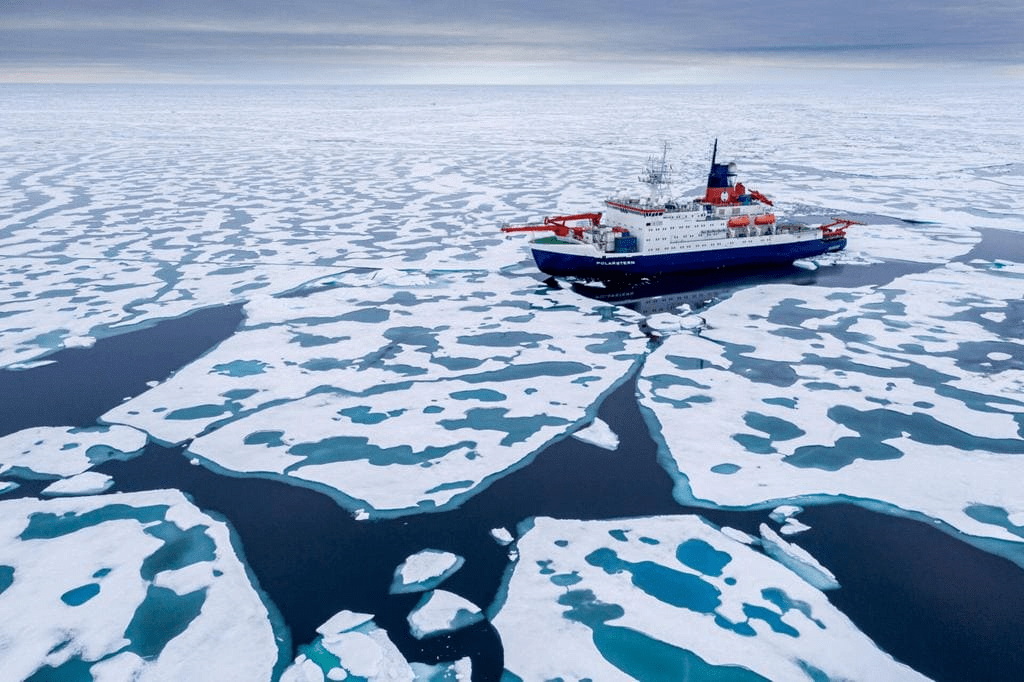 MOSAiC Expedition at the North Pole
MOSAiC Expedition at the North Pole
This was a project of $150 million organised by the Alfred Wegener Institute, Germany.
Core Points
- The Arctic Climate Study Multidisciplinary Drifting Observatory (MOSAiC) is an international research expedition to study the physical, chemical, and biological processes associated with the Arctic atmosphere, sea ice, oceans, and ecosystems.
- MOSAiC is the first expedition to the central Arctic to explore the Arctic climate system throughout the year.
- The distributed regional network of observation sites on the sea ice surrounding the RV Polarstern ship icebreaker was set up during the research's year-round operation.
- The RV Polarstern icebreaker is a German research vessel used primarily for research in the Arctic and Antarctica.
- The MOSAiC results will improve understanding of the regional and global implications of Arctic climate change and sea ice loss and improve weather and climate forecasts.
- In recent decades, the region's sea ice has been steadily decreasing, and this year's summer ice coverage was the second-lowest since satellite measurements began in 1979.
- The warming of older and thicker ice has also caused sharp declines.
- The collection of information on the Arctic ocean, ice, clouds, storms and ecosystems would prove invaluable in helping scientists understand the region that is warming faster than any other part of the planet.
Precision Agriculture
The Indian Council of Agricultural Research-Indian Agricultural Research Institute recently organized a "Sensors and Sensing for Precision Agriculture" (ICAR-IARI).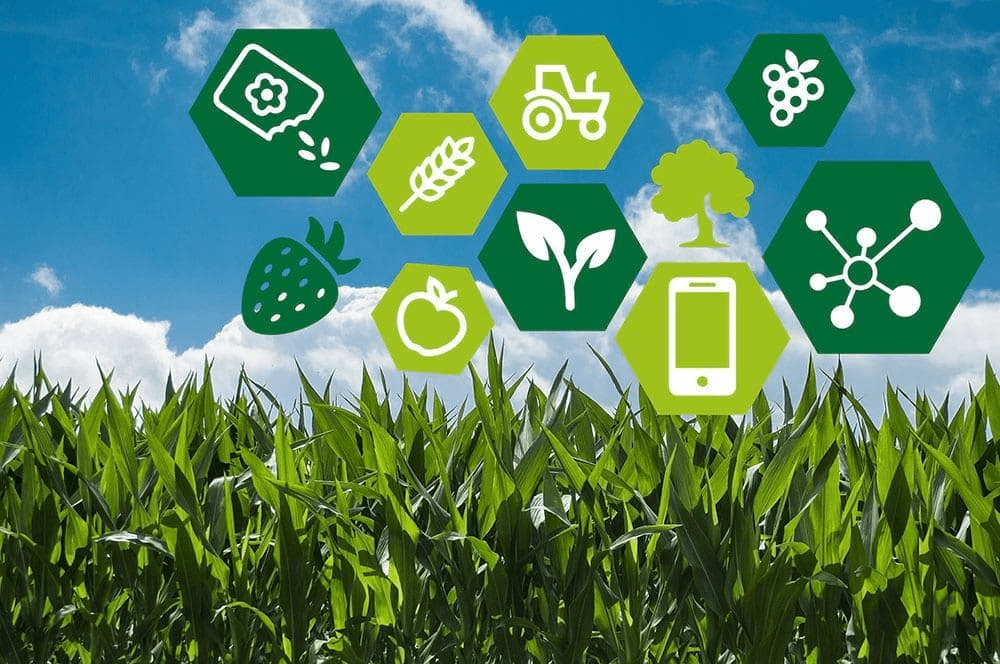 Wireless Sensing for Precision Agriculture
Wireless Sensing for Precision Agriculture
Precision Agriculture
- Precision agriculture (PA) is an approach where inputs are used to obtain higher average yields in precise amounts than conventional cultivation methods such as agroforestry, intercropping, crop rotation, etc.
- Sustainable PA is the most important innovation in farm management based on information and communication technologies in this century (ICTs).
- It is based on sustainable agriculture and healthy food production and consists of profitability and increased production, economic efficiency and the reduction of environmental side effects.
➤ Advantages
- Increases productivity in agriculture.
- Prevent the degradation of soil.
- Reduces the application of chemicals in crop production.
- Efficient exploitation of water resources.
- Disseminates modern farming practices to improve production quality, quantity and lower production costs.
- Changes in farmers' socio-economic status.
➤ Challenges
- Research suggests that the two most important challenges in the application of precision agriculture are educational and economic challenges.
- The lack of local experts, funds, knowledgeable research and extension staff has more impact than others among the variables that contribute to educational challenges.
- Compared to the other problems, PA and initial Costs have a greater effect on the economic challenges.
Core Points
➤ Session discussions
Recent advances in sensors, remote sensing, deep learning, artificial intelligence and the Internet of Things (IoT) for soil, plant and environment monitoring and quantification to enhance farm productivity with increased efficiency of input use and sustainability of the environment.
➤ Part of the VAIBHAV Summit:
- The session is part of the 2020 VaIBHAV Summit (VAIBHAV).
- VAIBHAV is an initiative of India's Government to bring together the culture of overseas and Indian scientists/academics in the thinking process, practices, research and development (R&D).
➤ Gaps in Research Identified:
- Development of indigenous low-cost sensors with integrated platforms, robotics, IoT for phenotyping of high throughput fields, and monitoring and managing soil and crop health.
- Phenotyping is the process of determining, analyzing or forecasting all or part of an organism's phenotype (observable physical properties of an organism).
 Phenotyping
Phenotyping
- Phenotyping is the process of determining, analyzing or forecasting all or part of an organism's phenotype (observable physical properties of an organism).
- Big data analytics and modelling for early sensor-based stress and discrimination detection in the agriculture sector.
- Standardized Unmanned Aerial Vehicle (UAV) protocols for imaging based on different sensors, inter-sensor calibration, and data analytics to monitor and manage crop conditions in near real-time.
- Development of affordable scale-neutral agricultural precision technologies appropriate to the Indian agricultural ecosystem.
- Scale neutrality means that one small land plot gives the same percentage of output as a large landholding if other things remain the same.
Right of Passage of Animals
The Supreme Court (SC) recently upheld the 2011 order of the High Court of Madras (HC) on the Nilgiris elephant's corridor, affirming the right of passage of animals and the closure of the resorts in the area.
Core Points
➤ Judgement of Madras HC
In 2011, the Madras HC confirmed the validity of the 2010 notification by the Tamil Nadu government declaring an 'Elephant Corridor' in the Sigur Plateau of Nilgiris District.
- It stated that the government is fully empowered to notify the elephant corridor in the state's Nilgiris district under the 'Project Elephant' of the Union government and Article 51 A(g) of the Constitution.
- Article 51 A(g): It is the duty of every person to protect and enhance the natural environment, including forests, lakes, rivers and wildlife, and compassion for living beings.
- Also, it upheld instructions to vacate lands falling within the notified elephant corridor for the resort owners and other private landowners.
➤ SC Judgment highlights
- It is the duty of the State to protect such elephants as "keystone species," which are extremely important to the environment.
- In ecology, keystone species, a species that has an unreasonably large impact on the populations in which it lives.
- Elephant corridors allow elephants to continue their nomadic survival mode by facilitating travel between separate forest habitats, despite shrinking forest cover. Such corridors play a crucial role in maintaining wildlife by reducing the impact of habitat isolation.
- The court also allowed creating a committee led by a retired HC judge and two other individuals within the corridor space to hear the individual objections of resort owners and private landowners.
- However, during the hearings, the SC thought that the area was a fragile ecosystem where men's will had to give way to elephants.
➤ Elephant Corridor from Nilgiris
- The corridor is situated in the ecologically fragile Sigur plateau, which connects the Western and the Eastern Ghats and sustains elephant populations and their genetic diversity.
 Nilgiri Corridor
Nilgiri Corridor - It is situated in the Nilgiris district near the Mudumalai National Park.
- It has the hills of Nilgiri on its southwest side and the Moyar River valley on its northeast side.
- There are about 100 elephant corridors in India, of which nearly 70 per cent are regularly used.
- In the southern, central and northeastern forests, 75 per cent of the corridors are only the Brahmagiri-Nilgiris-Eastern Ghats ranges are estimated to have 6,500 elephants.
➤ Elephant Corridor Challenges: 'Right of Passage',
- An 800-page study, authored by experts and published by the Wildlife Trust of India (WTI), released in August 2017, identifies and records information on India's 101 elephant corridors.
- Narrowing Passage Width: In 2017, only 22 per cent of corridors are one to three kilometres in width, Compared to 41 per cent in 2005, indicating how constricted corridors have become over the past 12 years.
Human Encroachment: 21.8% of corridors in 2017 were free of human settlements compared to 22.8% in 2005, and 45.5% in 2017 had 1-3 settlements compared to 42% in 2005.
Corridors Intercepted
- Approximately 36.4% of the elephant corridors in northwestern India, 32% in central India, 35.7% in northwestern Bengal, and 13% of the elephant corridors in northeastern India have a railway line passing through them.
- Almost two-thirds of the corridors have a national or state highway that passes through them, fragmenting habitats and further impeding elephants' movement.
- 11% of corridors have canals that pass through them.
- The mining and extraction of boulders affect 12% of them.
Land-use Along Corridors: In terms of land use, only 12.9% of the corridors were completely covered by forest in 2017, compared to 24% in 2005.
- Two of the country's three elephant corridors are now affected by agricultural activities.
- All corridors have agricultural land in northern West Bengal (100%) and nearly all in central India (96%) and northeastern India (52.2% under settled cultivation and 43.4% under slash and burn cultivation).
Bioremediation Mechanism for Oil Spills
An eco-friendly crude oil bioremediation mechanism technology has been developed by the National Institute of Ocean Technology (NIOT), Chennai, using consortia (a group of two or more species) of marine microbes immobilized (microbes controlled degradation) wheat bran (WB) on agro-residue bacterial cells.
Wheat bran is the wheat kernel's hard outer layer. In the milling process, it's stripped away. Bioremediation of Oil Spills
Bioremediation of Oil Spills
Core Points
Eco-friendly Bioremediation of Crude Oil Technology Mechanism
➤ Bioremediation:
- It can be described as any process using microorganisms or enzymes to remove and neutralize contaminants to their original condition within the environment.
- In the marine ecosystem, in the event of a spill, the deep sea hydrocarbonoclastic (hydrocarbon degradability) microbial consortium plays an important role in breaking down oil.
➤ Oil Spill:
- It is an accidental/uncontrolled release into the environment of crude oil, gasoline, fuels or other by-products of oil.
- Though mostly used for oceanic oil spills, oil spills can pollute land, air, or water.
- Approximately 1,000 tons of oil spilt into a sanctuary for rare wildlife after the Japanese ship hit a coral reef in 2020, the latest MV Wakashio spill off Mauritius.
Cause: This has become a major environmental problem, mainly due to the intensified exploration and production of petroleum on continental shelves and the transport of large quantities of oil in vessels.
Measure: It is becoming an increasingly difficult task to clean up oil spills from the oceans without damaging the marine ecosystem.
Containment Booms: Floating barriers, called booms, are used to limit the distribution of oil and to enable it to be recovered, removed or dispersed.
Skimmers: They are devices used to separate spilled oil from the surface of the water physically.
Sorbents: Various sorbents are used (e.g. straw, volcanic ash, and polyester-derived plastic shavings) that absorb the oil from the water.
Dispersing agents: These are chemicals that contain surfactants or compounds that break up small droplets of liquid substances such as oil.
They speed up the natural dispersion of it into the sea.
- The primary energetic degraders of a complex mixture of petroleum hydrocarbons into different aldehydes, ketones and acidic metabolites serve as the microbial community.
- These bacteria that degrade hydrocarbons do not rely on hydrocarbons for survival but have a metabolic mechanism in which they use petroleum products as a source of carbon and energy and help clean up oil spills.
- Using wheat bran marine bacterial consortia (which are low-cost non-toxic agro-residues) in an environmentally sustainable manner, full breakdown and crude oil degradation are achievable.
Advantages of the Immobilized State:
- They are more effective in degrading oil spills in their immobilized state than the free bacteria cells.
- Within 10 days, they could remove 84 per cent of the oils. A maximum of 60% of the crude oil was degraded by free bacterial cells under optimized conditions.
- They are more flexible and resistant to adverse circumstances.
- They have efficacy through non-toxic clean-up technology in treating accidental bulk discharge of oil in marine environments.
State of Global Air 2020: HEI
Recently, the Health Effects Institute released a global study, State of Global Air 2020 (SoGA 2020) (HEI).
It highlights that air pollution is the largest risk factor for death, and it is the first-ever comprehensive analysis of the global impact of air pollution on newborns.
HEI is a non-profit, independent research institute jointly funded by the Environmental Protection Agency of the United States and others.
Core Points
- India, Bangladesh, Pakistan and Nepal are among the top ten countries with the highest exposure to PM2.5 (particulate matter) in 2019. Between 2010 and 2019, all of these nations experienced increases in outdoor PM2.5 levels.
- India is also among the top ten countries with the highest exposure in 2019 to ozone (O3).
- India recorded the highest increase (17 per cent) in O3 concentrations in the past ten years among the 20 most populous countries.
- Long-term exposure to outdoor and household in India, over 1.67 million annual deaths from stroke, heart attack, diabetes, lung cancer, chronic lung diseases, and neonatal diseases were caused by (indoor) air pollution in 2019.
Important initiatives for the Government
- Pradhan Mantri Ujjwala Yojana Yojana (Household LPG programme).
- National Program for Clean Air.
- Introduction of standards for BS-VI emissions.
- Implementation of the Graded Response Action Plan (GRAP).
Data Related to Infant
- The deaths of more than 1,16,000 Indian infants who did not survive their first month were caused by high PM.
- Infants are already at a vulnerable stage in the first month of life. A growing body of scientific evidence-supported studies in India indicates that low birth weight and preterm birth are linked to particulate air pollution exposure during pregnancy.
- More than half of these fatalities were associated with PM2.5 outdoors, and others were associated with solid fuels for cooking, such as charcoal, wood, and animal dung.
- Although household reliance on poor quality fuels has been slowly and steadily reduced, air pollution from these fuels continues to be a key factor in the deaths of these youngest infants.
Pollution from the air and Covid-19
- Although the connection between air pollution and Covid-19 is not fully established, there is clear evidence that air pollution and increased heart and lung disease are connected.
- There is also growing concerned that exposure in South Asian countries and East Asia to high levels of air pollution during the winter months could exacerbate the effects of Covid-19.
Status of Current Pollution:
- Over the past three years, average levels of pollution in India have decreased. Still, they have been marginal, especially in the Indo-Gangetic plains, which see extremely high PM pollution, especially during winter.
Following a decrease in pollution due to the national lockdowns after March, pollution levels are rising again, and air quality in several cities is dipping to the 'very poor' category.
Translocation of Corals in Mumbai
Under the Mumbai Coastal Road Project, the National Institute of
Oceanography will translocate 18 coral colonies from the coast of Mumbai.
Core Points
➤ Corals
- These exhibit plant characteristics, but they are marine animals linked to jellyfish and anemones.
- Genetically identical organisms called polyps, which are small, soft-bodied organisms, are made up of them.
- A hard, protective limestone skeleton called a calicle, which forms coral reefs' structure, is at their base.
- These polyps have microscopic algae living within their tissues, called zooxanthellae.
- There is a mutualistic (symbiotic) relationship between the corals and algae under which Coral supplies the zooxanthellae with the necessary compounds for photosynthesis.
- In exchange, zooxanthellae provide the coral with organic photosynthesis products, such as carbohydrates, used by coral polyps to synthesize their calcium carbonate skeletons.
- The unique and beautiful colours of corals are also responsible for the Zooxanthellae.
There are 2 coral types:
- Stony, shallow-water corals, the kind of reefs that are constructed.
- Corals of soft and deep water that live in dark, cold waters.
Wheat Variety MACS 6478
In Karanjkhop, a village in Maharashtra, the wheat variety called MACS 6478 has doubled the crop yield for farmers.
Core Points
- Developed by: Agharkar Research Institute (ARI) scientists, Pune-an autonomous institute of the Ministry of Science and Technology (DST).
➤ Features:
- Generic wheat or bread wheat (Triticum aestivum).
- Durum wheat (T. durum) and club wheat are other common wheat varieties (T. compactum).
- Hybrid Crop, i.e. produced by the crossbreeding of two varieties or species of genetically different species.
- When open-pollinated plants naturally cross-pollinate with other related varieties, hybrids are often created spontaneously and randomly in nature (not genetically modified).
- It ripens in 110 days and is resistant to most leaf and stem rust breeds.
- This is against the normal maturation required for wheat varieties commonly cultivated in northern India, achieved after 140 to 150 days.
- This medium-sized amber coloured grain contains 14 percent protein, zinc 44.1 ppm (parts per million), and iron 42.8 ppm, which is greater than other cultivated varieties.
With the new variety, farmers get a yield of 45-60 quintals per hectare compared to the previous average yield of 25-30 quintals per hectare when cultivating Lok 1, HD 2189 and other old varieties.
Typhoon Molave: Vietnam
Vietnam has been hit by Typhoon Molave recently, one of its largest storms in two decades. In the rainy season between June and November, Vietnam is prone to natural disasters, with central coastal provinces commonly affected, but the storms have notably worsened in recent years.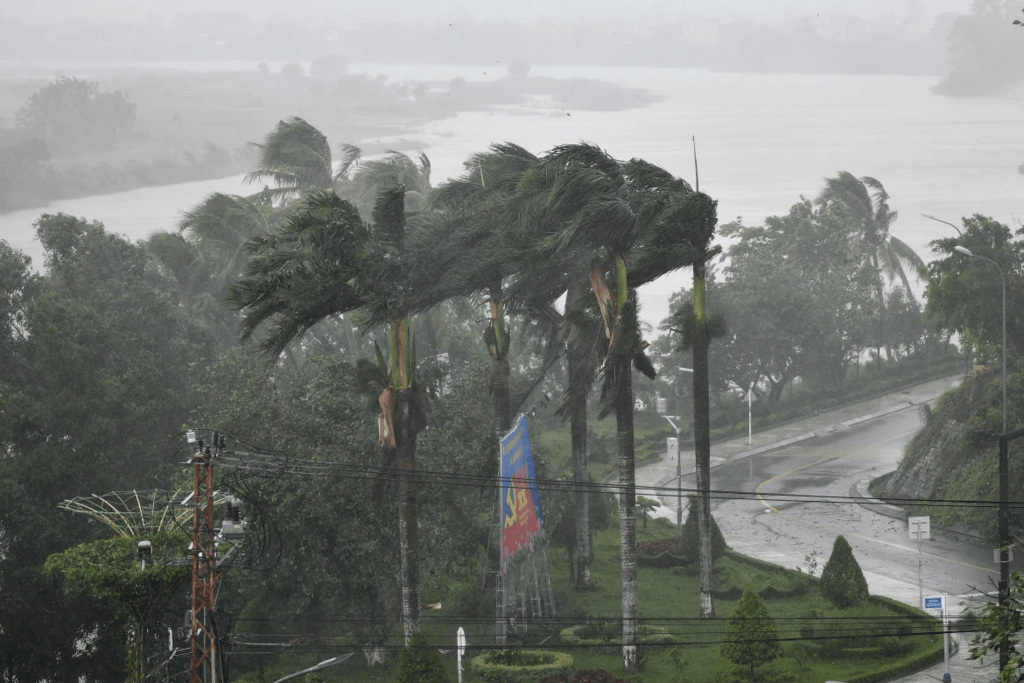 Typhoon Molave: Vietnam
Typhoon Molave: Vietnam
Core Points
For a strong tropical cyclone, the Typhoon is a regionally specific name.
Tropical cyclones are recognized as:
- Northwest Pacific Ocean- typhoons.
- North Atlantic Ocean- hurricanes.
- Willy-willies in north-western Australia.
- Tropical Cyclones in the Indian Ocean Region.
A tropical cyclone is a generic term used by meteorologists to describe a rotating, organized, low-level circulation system of clouds and thunderstorms originating in tropical or subtropical waters.
The Northern Hemisphere's tropical cyclones rotate counterclockwise.
The Wind Scale measures these for the Saffir-Simpson Hurricane.
Typhoon Naming: The Tokyo Typhoon Centre Regional Specialized Meteorological Centre (RSMC) assigns a name to a tropical cyclone.
The Philippines is responsible for the name 'Molave'.
|
31 videos|145 docs|28 tests
|
FAQs on October 2020: Current Affairs Environment & Ecology- 2 - Environment & Additional Topics for State PSC Exams - BPSC (Bihar)
| 1. What is the significance of precision agriculture? |  |
| 2. How does bioremediation help in cleaning up oil spills? |  |
| 3. What is the State of Global Air 2020: HEI report about? |  |
| 4. How does translocation benefit coral reefs in Mumbai? |  |
| 5. What are the characteristics of the wheat variety MACS 6478? |  |
|
31 videos|145 docs|28 tests
|

|
Explore Courses for BPSC (Bihar) exam
|

|
